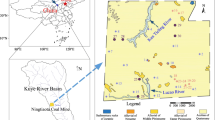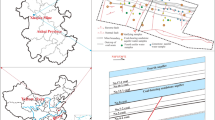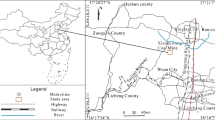Abstract
Mine water inrush is one of the major geological hazards that threaten safe production in coal mines. The accurate identification of mine water inrush sources plays a vital role in mine water disaster control, and it is the key to preventing mine water inrush incidents. Ninety-three water samples were extracted from the three types of aquifers in the Qinan coal mine. The cluster analysis method was then used to analyze 82 of the original water samples, and the other 11 water samples that did not meet the requirements were removed. Then, the remaining 82 water samples were regarded as training samples, and the principal component analysis was completed. Taking the scores of the principal components as the independent variable and the types of water inrush sources as the dependent variable, the multiple logistic regression recognition model was established. Meanwhile, this recognition model was used to recognize the types of mine water inrush sources and verify the recognition accuracy for the 82 training samples. The comprehensive recognition accuracy reached 86.6%, which is much higher than the traditional recognition methods of water inrush sources. Based on cluster analysis, the multiple logistic regression recognition model fully considers the ion content measurement errors and the complex relationships between the internal ions, and this recognition model is more reasonable and improves the accuracy of water inrush source recognition. This paper provides a new method for recognizing the problem of water inrush sources, which also provides an effective basis for mine water inrush prevention and control.







Similar content being viewed by others
References
Biswas A, Sharma SP (2017) Geophysical surveys for identifying source and pathways of subsurface water inflow at the Bangur chromite mine, Odisha, India. Nat Hazards 88(2):947–964
Bu HM, Tan X, Li SY, Zhang QF (2010) Water quality assessment of the Jinshui River (China) using multivariate statistical techniques. Environ Earth Sci 60(8):1631–1639
Chen HJ, Li XB, Liu AH, Peng SQ (2009) Identifying of mine water inrush sources by Fisher discriminant analysis method. J Cent South Univ 40:1114–1120
Chen LW, Yin XX, Liu X, Gui HR (2013) Multivariate statistical analysis on hydrochemical evolution of groundwater in the concealed coal mines in North China. Coal Geol Explor 41(6):43–51
Faghih Nasiri E, Yousefi Kebria D, Qaderi F (2018) An experimental study on the simultaneous phenol and chromium removal from water using titanium dioxide photocatalyst. Civ Eng J 4(3):585
Farnham IM, Stetzenbach KJ, Singh AK, Johannesson KH (2000) Deciphering groundwater flow systems in Oasis Valley, Nevada, using trace element chemistry, multivariate statistics, and geographical information system. Math Geosci 32(8):943–968
Ganyaglo SY, Banoeng-Yakubo B, Osae S, Dampare SB (2011) Water quality assessment of groundwater in some rock types in parts of the eastern region of Ghana. Environ Earth Sci 62:1055–1069
Gui HR, Lin ML (2016) Types of water hazards in China coalmines and regional characteristics. Nat Hazards 84(2):1501–1512
Güler C, Thyne GD, McCray JE, Turner KA (2002) Evaluation of graphical and multivariate statistical methods for classification of water chemistry data. Hydrogeol J 10(4):455–474
Hu W, Dong S, Yan L (2011) Water hazard control technology for safe extraction of coal resources influenced by faulted zone. Procedia Earth Planet Sci 3:1–10
Huang PH, Chen JS (2011) Fisher identify and mixing model based on multivariate statistical analysis of mine water inrush sources. J China Coal Soc 36(S1):131–136
Huang PH, Wang XY (2018) Piper-PCA-Fisher recognition model of water inrush source: a case study of the Jiaozuo mining area. Geofluids 2018:1–10
Huang PH, Yang ZY, Wang XY, Ding FF (2019) Research on Piper-PCA-Bayes-LOOCV discrimination model of water inrush source in mines. Arab J Geosci 12:334
Jolliffe IT (2002) Principal component analysis. Wiley, Hoboken
Keskin TE, Düğenci M, Kaçaroğlu F (2015) Prediction of water pollution sources using artificial neural networks in the study areas of Sivas, Karabük and Bartın (Turkey). Environ Earth Sci 73(9):5333–5347
Kim JH, Kim RH, Lee J, Cheong TJ, Yum BW, Chang HW (2005) Multivariate statistical analysis to identify the major factors governing groundwater quality in the coastal area of Kimje. South Korea. Hydrol Process 19(6):1261–1276
Li GQ, Meng ZP, Wang XQ, Yang J (2017) Hydrochemical prediction of mine water inrush at the Xinli Mine, China. Mine Water Environ 36(1):78–86
Liu X, Chen LW, Lin ML, Li SD (2013) Fisher recognition analysis for coal mining inrush water source under mining-induced disturbance and inversion of groundwater recharge relation. Hydrol Eng Geol 40(4):36–43
Liu Q, Sun YJ, Xu ZM, Xu G (2018) Application of the comprehensive identification model in analyzing the source of water inrush. Arab J Geosci 11(9):189
Lu JT, Li XB, Gong FQ (2012) Recognizing of mine water inrush sources based on principal components analysis and fisher discrimination analysis method. China Saf Sci J 22(7):109–115
Meglen RR (1992) Examining large databases: a chemometric approach using principal components analysis. Mar Chem 39(1):217–237
Panagopoulos GP, Angelopoulou D, Tzirtzilakis EE, Giannoulopoulos P (2016) The contribution of cluster and discriminant analysis to the classification of complex aquifer systems. Environ Monit Assess 188:591
Qian J, Wang L, Ma L, Lu YH, Zhao WD, Zhang Y (2016) Multivariate statistical analysis of water chemistry in evaluating groundwater geochemical evolution and aquifer connectivity near a large coal mine, Anhui, China. Environ Earth Sci 75(9):747
Reghunath R, Murthy TRS, Raghavan BR (2002) The utility of multivariate statistical techniques in hydrogeochemical studies: an example from Karnataka, India. Water Res 36(10):2437–2442
Wang LB (2010) Multivariate statistical analysis: models, case study and application of SPSS. Economic Science Press, Beijing
Wang JC, Guo ZG (2001) Logistic regression model-methods and applications. Higher Education Press, Beijing
Wang XY, Zhao W, Liu XM, Wang TT, Zhang JG, Guo JW, Chen GS, Zhang B (2017a) Identification of water inrush source from coalfield based on entropy weight-fuzzy variable set theory. J China Coal Soc 42(9):2433–2439
Wang Y, Zhou MR, Yan PC, He CY, Liu D (2017b) Identification of coalmine water inrush source with PCA-BP model based on laser-induced fluorescence technology. Spectrosc Spectr Anal 37(3):978–983
Wei WX, Han J, Shi LQ, Lu XM, Zhang XJ (2015) Application of modern data analysis in mine water gushing prediction. Coal Industry Press, Beijing
Wu Q, Guo XM, Shen JJ, Xu S, Liu SQ, Zeng YF (2016) Risk assessment of water inrush from aquifers underlying the Gushuyuan coal mine, China. Mine Water Environ 36(1):1–8
Xu B, Zhang Y, Jiang L (2012) Coupled model based on grey relational analysis and stepwise discriminant analysis for water source. Rock Soil Mech 33(10):3122–3228
Yin XX, Xu GQ, Gui HR, Chen LW (2006) Analyzing for sources of inrush-water in Wanbei Mining Area by systemic clustering and stepwise distinguishing. Coal Geol Explor 34(2):61–64
Zhang WT (2002) SPSS 11.0 statistical analysis tutorial (advanced). Beijing Hope Electronic Press, Beijing
Zhang H, Yao DX, Lu HF, Zhu NN, Xue L (2017) Application of principal component analysis and bayes discrimination approach in water source identification. Coal Geol Explor 45:87–93
Acknowledgements
The project was supported by the National Natural Science Foundation of China (Grant nos. 41672273, 51474008), the Fundamental Research Funds for the Central Universities (22120180313) and the Anhui Natural Science Foundation of China (1508085QE89). The research was also substantially supported by the Key Laboratory of Geotechnical and Underground Engineering of Ministry of Education (Tongji University).
Author information
Authors and Affiliations
Corresponding author
Additional information
Publisher's Note
Springer Nature remains neutral with regard to jurisdictional claims in published maps and institutional affiliations.
Rights and permissions
About this article
Cite this article
Zhang, H., Xing, H., Yao, D. et al. The multiple logistic regression recognition model for mine water inrush source based on cluster analysis. Environ Earth Sci 78, 612 (2019). https://doi.org/10.1007/s12665-019-8624-2
Received:
Accepted:
Published:
DOI: https://doi.org/10.1007/s12665-019-8624-2




